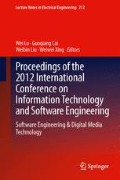Abstract
Geometric invariants have wide applications in computer vision. In most of existing methods, 3D invariants have been obtained from reconstruction, where fundamental matrices between image pairs should be firstly established. Consequently, additional computation errors are introduced during invariants construction. Moreover, it is very time consuming. In this paper, a novel method is proposed to calculate 3D projective invariants from images, without reconstruction. Furthermore, the represented framework is valid even when prior information about corresponding features is not enough for reconstruction. It has been verified in experiments that the proposed method is considerably accurate compared with ground truth, and more efficient compared with reconstruction based methods.
Access this chapter
Tax calculation will be finalised at checkout
Purchases are for personal use only
References
Weiss I (1993) Geometric invariants and object recognition. Int J Comput Vision 10:207–231
Wu YH, Hu ZY (2003) The invariant representations of a quadric cone and a twisted cubic. IEEE Trans Pattern Anal Mach Intell 25:1329–1332
Begelfor E, Werman M (2006) Affine invariance revisited. IEEE comput soc conf comp vision pattern recognit 2:2087–2094
Bayro-Corrochano E, Banarer V (2002) A geometric approach for the theory and applications of 3D projective invariants. J Math Imag Vision 16:131–154
Lasenby J, Bayro-Corrochano E, Lasenby AN, Sommer G (1996) A new framework for the formation of invariants and multiple-view constraints in computer vision. International conference on image processing 1:313–316
Maybank SJ (1998) Relation between 3D invariants and 2D invariants. Image Vis Comput 16:13–20
Sung-Woo L, Bum-Jae Y, Hager GD (1999) Model-based 3D object tracking using projective invariance. IEEE international conference on robotics and automation 2:1589–1594
Tico M, Rusu C, Kuosmanen P (1999) A geometric invariant representation for the identification of corresponding points. International conference on image processing 4: 462–466
Tsui HT, Zhang ZY, Kong SH (1997) Feature tracking from an image sequence using geometric invariants. IEEE computer society conference on computer vision and pattern recognition 1:244–249
Forsyth D, Mundy JL, Zisserman A, Coelho C, Heller A, Rothwell C (1991) Invariant descriptors for 3D object recognition and pose. IEEE Trans Pattern Anal Mach Intell 13:971–991
Moses Y, Ullman S (1998) Generalization to novel views: universal, class-based, and model-based processing. Int J Comput Vision 29:233–253
Kyoung Sig R, Bume Jae Y, In So K (1998) 3D object recognition using projective invariant relationship by single-view. IEEE international conference on robotics and automation 4:3394–3399
Zhu Y, Seneviratne LD, Earles SWE (1995) A new structure of invariant for 3D point sets from a single view. IEEE international conference on robotics and automation 2:1726–1731
Weiss I, Ray M (2001) Model-based recognition of 3D objects from single images. IEEE Trans Pattern Anal Mach Intell 23:116–128
Basri R, Moses Y (1999) When is it possible to identify 3D objects from single images using class constraints. Int J Comput Vision 33:95–116
Csurka G, Faugeras O (1999) Algebraic and geometric tools to compute projective and permutation invariants. IEEE Trans Pattern Anal Mach Intell 21:58–64
Long Q (1995) Invariants of six points and projective reconstruction from three uncalibrated images. IEEE Trans Pattern Anal Mach Intell 17:34–46
Schaffalitzky I, Zisserman A, Hartley R, Torr P (2000) A six point solution for structure and motion. Lect Notes Comput Sci 1842:632–648
Yan X, Jia-Xiong P, Ming-Yue D, Dong-Hui X (1997) The unique solution of projective invariants of six points from four uncalibrated images. Pattern Recogn 30:513–517
Long Q, Kanade T (1997) Affine structure from line correspondences with uncalibrated affine cameras. IEEE Trans Pattern Anal Mach Intell 19:834–845
Weng J, Huang TS, Ahuja N (1992) Motion and structure from line correspondences; closed-form solution, uniqueness, and optimization. IEEE Trans Pattern Anal Mach Intell 14:318–336
Song BS, Lee KM, Lee SU (2001) Model-based object recognition using geometric invariants of points and lines. Comput Vis Image Underst 84:361–383
Lasenby J, Bayro-Corrochano E (1997) Computing 3D projective invariants from points and lines. Lect Notes Comput Sci 1296:82–89
Lowe DG (2004) Distinctive image features from scale-invariant keypoints. Int J Comput Vision 60:91–110
Author information
Authors and Affiliations
Corresponding author
Editor information
Editors and Affiliations
Rights and permissions
Copyright information
© 2013 Springer-Verlag Berlin Heidelberg
About this paper
Cite this paper
Wang, X., Chen, X., Qu, S. (2013). Three-Dimensional Geometric Invariant Construction from Images. In: Lu, W., Cai, G., Liu, W., Xing, W. (eds) Proceedings of the 2012 International Conference on Information Technology and Software Engineering. Lecture Notes in Electrical Engineering, vol 212. Springer, Berlin, Heidelberg. https://doi.org/10.1007/978-3-642-34531-9_35
Download citation
DOI: https://doi.org/10.1007/978-3-642-34531-9_35
Published:
Publisher Name: Springer, Berlin, Heidelberg
Print ISBN: 978-3-642-34530-2
Online ISBN: 978-3-642-34531-9
eBook Packages: EngineeringEngineering (R0)

